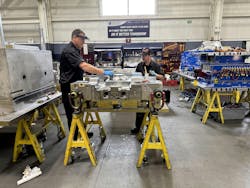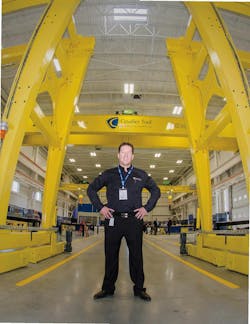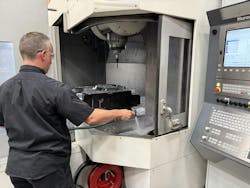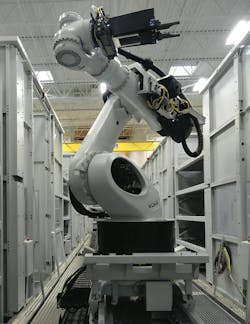Cavalier Tool relies on 'people, process, equipment'
What you'll learn:
-
Cavalier Tool & Manufacturing, based in Windsor, Ont., builds 300 injection molds annually for presses up to 4,400 tons.
-
A defined process with upfront feasibility studies and simulations makes Cavalier 20 to 30 percent faster than most competitors.
-
Global engineering and design teams in India enable around-the-clock operations, cutting design times by nearly half.
-
Heavy investments in automation, robotics and high-end machining centers drive efficiency, accuracy and reduced downtime.
-
Cavalier combines North American and Asian mold-building resources under strict standards, ensuring quality and global cost competitiveness.
By Ron Shinn
Building intricate injection molds requires skilled people and first-rate equipment. But that is not really enough for a mold making business to thrive at the highest level.
It takes a defined process to make it all work. It also helps to have passion for the product.
“People, process, equipment,” said Brian Bendig, president and CEO of Cavalier Tool & Manufacturing Ltd. in Windsor, Ontario. “The right people doing the right things on the right equipment.”
In addition to putting together the right people, process and equipment, Cavalier has become a global manufacturer like no other, with design, manufacturing and other support services being accomplished around the world under the company’s direction and standards. Cavalier’s network speeds up project completion and can reduce costs for mold buyers.
Developing the process has been key to Cavalier becoming one of the best mold makers in the world.
The process starts with the sales team consulting on the best solution for a mold.
A Design for Manufacturing (DFM) team analyzes part feasibility, then designs the best tool possible for optimal cycle time, ease of setup, cost-effectiveness and long tool life. All this before a sales contract is signed.
Then, machining, tool building, tryout and production support complete the process. Highly skilled project managers oversee design reviews and monitor build progress.
“We not only estimate [tool cost], we put in the feasibility work,” Bendig said. Feasibility means identifying problems such as an incorrect radius.
“We do extremely well with startups that have 20 to 30 presses because we show them how to design their parts,” Bendig said. “We show them how to design their tools. We’re their Tylenol. We want it to be pain-free.”
Simulations play a key part in Cavalier’s process and represent a significant value-add for customers. Every tool goes through a two-stage simulation process to eliminate the possibility of collisions, interferences and anything that could cause a crash.
Stage 1 simulation occurs during the feasibility process. Stage 2 takes place after the mold is fully designed. In addition to the mechanical simulation, there is mold flow analysis and cooling analysis.
Cavalier uses Siemens software for mechanical simulation. Small and start-up mold making shops often cannot afford the $50,000-plus annual cost of the software. “It’s quite expensive, but it saves crashes,” Bendig said.
Cavalier builds about 300 injection molds per year, focusing primarily on molds for mid-sized to large products, to run on presses from 250 tons to 4,400 tons of clamping force. Most are sold to processors in North America, and they’re used in a wide variety of industries.
Mold types include standard injection, aluminum, gas counter pressure, compression, injection compression, multi-shot, structural foam and stack molds.
Bendig estimates Cavalier is 20 percent to 30 percent faster than most of its competitors in delivering a finished mold. He said Cavalier’s up-front design work is the “secret sauce” to make that happen.
In addition to being faster than most shops, Cavalier has an on-time delivery rate of 96 percent and rarely has to deal with customer complaints.
“Our top five customers probably haven’t been in our building in the past five years,” Bendig said. “There’s no reason to come. There’s never a problem. Our tools always run their parts.”
That is a reputation Bendig guards closely. “You do something bad, and they never forget. They forget all those good things you did and only talk about the bad things,” he said. “The best thing to do is, don’t make any mistakes.”
Worldwide network
Cavalier opened in 1975 on the day Bendig was born. The original owners were Ray Bendig, Brian’s father, and two business partners. Ray Bendig had to rush from the hospital the morning Brian was born because he had the key to the front door of the new shop.
Today, Cavalier, wholly owned by Brian Bendig, has 235 employees in three plants in the Windsor area, plus three locations in India that do design, engineering and cost-estimating work. The India locations mean Cavalier can operate around the clock by sharing work in the cloud.
Cavalier’s designers in India work two shifts. “Technically speaking, we can design up to 30 hours per day,” Bendig said. “We can take a six-week design time down to three or four weeks.”
Sharing files in the cloud is a skill Cavalier learned during the COVID-19 pandemic.
The shop floor is also heavily automated.
Sales were approximately $95 million last year and the company projects them to grow by about 20 percent this year.
Cavalier also has a network of mold builders in Asia, primarily in Vietnam, India and China, that can build molds or mold components if a customer prefers. The entire process is managed from Windsor, and the final mold gets a Cavalier warranty.
Cavalier has built about 30 complete molds offshore.
Each tool built offshore gets a “Cavalier stamp of approval” before the company ships it to the processor, GM Doug Brockman said.
“Anybody can go to a broker and acquire a cheap tool for a cheap price,” Brockman said. “But, at Cavalier, we manage it. We review the design just like it is a Cavalier North American-built tool. We hold our supply base to our standard, and when the tool comes here, we verify, validate and provide our warranty for it.
“It is all about our warranty and our brand,” he said. “In the end, we are going to put our name behind it.”
Has the industry’s movement to sourcing molds from China hurt Cavalier’s business?
“No, not at all,” Bendig said. “Our sales continue to go up 20 percent to 30 percent year over year. We have started embracing offshore for components and full builds.”
Building the Cavalier brand
The Cavalier brand is always under construction. “Building our brand is something I have always been good at,” Bendig said. “I suck at golf. This is my world. This is what I do, so this is where I focus.”
Bendig also said that cutting quality on a Cavalier mold — regardless of where it is being built — is not something he wants to consider.
“I am not a good guy for cutting quality to save money,” he said. “Don’t ask me that. If a customer wants P20 steel, we are delivering P20. That’s all there is to it. Don’t ask us for a cheap tool.”
Building and maintaining a skilled workforce is an ongoing effort. Bending estimated that in the 1980s, there were as many as 300 mold shops in the Windsor-Essex area but probably fewer than 75 today.
“Because we are a newer shop, a bigger shop, and we are well known as a non-automotive shop, a lot of people want to come here.” Bendig said that many tool makers want to avoid the boom-and-bust of automotive business cycles. Cavalier has only 7 percent of its business in molds for the auto industry.
He said employees tend to stay at Cavalier for a long time. Twenty-five to 40 years is not uncommon.
Bendig refers to the workforce as the Cavalier Army. That started years ago when a mold project would come in with a tight deadline and he would need to throw an army of workers on the project to meet the deadline.
“The Army goes to war to win, and you’ve got to win a lot of battles to win the war,” he said. “I view our business a little bit that way.”
Being faster than competitors has helped Cavalier grow in molds Bendig broadly describes as being for consumer parts and products — things consumers buy at Home Depot and Walmart.
“We will quote something this week and get the purchase order next week. It is that fast,” he said. Brand owners frequently want these products on store shelves as quickly as possible. This is where Cavalier’s fast process pays off.
“Speed is one thing people will buy,” he said.
He said another fast-growing area for Cavalier is in American infrastructure products. “Where they were once using satellites, now there is a big push to put stuff back in the ground. So, hospitals are connected to police stations, which are connected to fire stations, and so forth.”
Top-end equipment
While the design-and-build process has been a key to Cavalier’s success, the type of equipment it buys is also critical.
Brockman estimated the company spends between 4 and 6 percent of revenue each year on new equipment.
Bendig travels the world visiting machinery manufacturers. He said he likes to walk their production floors to see firsthand the quality that goes into their products.
Once he finds a machinery vendor he likes, he works with it on modifications to fit Cavalier’s requirements.
Bendig will often buy two or three units of the same, high-quality machine. “If you get a good piece and twin them, the operators are the same, the tooling is the same.”
Instead of assigning a job to a specific machine, Cavalier likes to assign it to whatever machine is open. “The operators can run them all,” Bendig said.
Cavalier added six new machines last year and has already bought five this year.
Bendig said the technology curve for machinery used in mold building is 10 to 15 years, so keeping ahead of that means keeping pace with the most impactful new technologies.
“We buy very high-end machines with a 10-to-15-year lifespan,” Bendig said. “We use a five-year loan so we are aggressively paying off the loan.
“We maintain the heck out of a machine and run it around the clock. When we sell it after 10 to 15 years, we get a good dollar for it.”
Another strategy is to add plenty of options to the machine. “We can grow into equipment that has more options, and it has greater resale value when you go to sell it,” Bendig said.
Automation is another key point when Bendig purchases equipment. He said he looks for equipment that can speed up production.
Bendig said the company has 44 pieces of significant equipment.
An Okuma MCR-BV double column machining center was added this year. Cavalier has operated two Okuma MCR-A5CII units for several years. The new machine can handle work pieces up to 160 inches long requiring up to 35 tons of material and cut more complex toolpaths.
The MCR-BV adapts to each operation, swaps heads and tools automatically and holds tight tolerances. It has greater horsepower and multi-axis machining capabilities to perform multiple operations with a single setup.
Cavalier has an EDM cell built around an Eagle 1400 unit and five-axis robot. Maintenance manager Rob Wilson said the turnkey cell changed the way Cavalier builds molds. “It took us from the old-school to a new way of doing things,” Wilson said.
The robot reads an RFID tag and loads parts into a five-axis mill from OPS-Ingersoll. Each electrode is tagged. “The machines know where the part is at all times,” Wilson said. “You cannot put the wrong electrode in and it cannot get burned in the wrong spot.”
The automated cell takes the graphite blanks to be cut, then to the EDM to be burned. The robot can hold 191 electrodes and five pallets.
The Windsor plant has three Italian-built Millutensil spotting presses for making final adjustments and accuracy checks.
A mold is loaded into the press and closed to verify there is a perfect seal between the mold halves. The Millutensil machines have sensors built into each corner to make sure the mold halves are perfectly level when closed. The sensors raise the Millutensil units above most other spotting presses.
The MIL 253 has a maximum clamping force of 200 tons and lower platen load capacity of 54 tons. The MIL 306 has a maximum clamping force of 400 tons and maximum lower platen load capacity of 88 tons.
Another cell consists of three Hermle machining centers serviced by a Kuka robot on a 60-foot linear track. There is space to add four more machines to the cell.
The robot significantly increases the throughput of each machine in the cell, according to Wilson. “You are not limited to the operator being at the machine,” he said.
Wilson said he does not believe there is another cell like this in North America.
Work is currently underway digging a nearly 200-foot long pit for two Makino V100S, five-axis finishing mills scheduled to be installed in October. They will be the first in North America.
The highly accurate mill has a 20,000-rpm spindle that will make it one of Cavalier’s fastest and most accurate finishing mills. Brockman said this was purchased with expected growth in mind.
On the horizon
Cavalier also repairs and refurbishes molds regardless of the company that built them. Refurbishment is not currently considered a separate profit center.
Brockman said the repair department has four employees and stresses quick turnaround.
Here are some additional highlights from a walk-through of Cavalier’s plant:
- The plant has four remote-controlled carts to move molds throughout the facility and between buildings. The carts can carry up to 25 tons.
- There is no shortage of overhead cranes because waiting for a crane was once identified as slowing down mold construction. Bendig said there are about 20 overhead cranes with two more soon to be installed. Cranes are configured to run above or under each other to eliminate bottlenecks and prevent work from being stopped when molds are moved.
- The plant has a Kardex system to store trays of small parts and components needed for each mold build. An employee can access the tray for a project at any time.
- Any information a tool maker needs is available 24/7 in the plant via a digital network. Every worker knows how to access and use the system.
What’s ahead for Cavalier?
Brockman talked about more sophisticated equipment the company is likely to buy in 2026, and Bendig plans to continue looking for partners in Asia and visiting machinery builders around the world. Both are bullish about the outlook.
The Cavalier Army marches on.
Contact
Cavalier Tool, Windsor, Ontario, 519-944-2144, www.cavaliertool.com
About the Author
Ron Shinn
Editor
Editor Ron Shinn is a co-founder of Plastics Machinery & Manufacturing and has been covering the plastics industry for more than 35 years. He leads the editorial team, directs coverage and sets the editorial calendar. He also writes features, including the Talking Points column and On the Factory Floor, and covers recycling and sustainability for PMM and Plastics Recycling.




